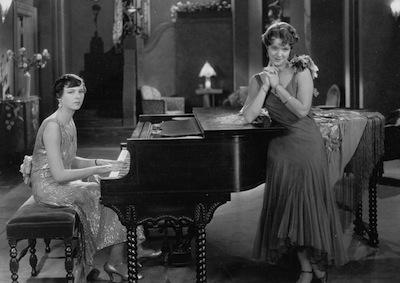Vitaphone #917
The tiny and winsome Molly Picon was a major star of the Yiddish theater, toured in vaudeville, starred in her own radio program, and made starring appearances in Yiddish-language films as well as in three Vitaphone shorts. This short's disk was missing until 2011, and shows off the star's versatility. In 1933, she headlined a rare Vitaphone three-reeler, A Little Girl with Big Ideas, and later appeared on Broadway in Fiddler On The Roof (as Yenta the Matchmaker), and Come Blow Your Horn. In an obscure Vitaphone connection, she appeared as Jerry Lewis' mother in the 1959 television version of The Jazz Singer. She is perhaps best known for her multiple appearances as Mrs. Bronson in Car 54 Where Are You?
35mm, b&w, 10 min.
Herschel Henlere, The Madcap Musician (1929)
Vitaphone #933
In some ways recalling Victor Borge's later act, Henlere toured extensively and internationally, mocking classical music in a decidedly bizarre manner. He was billed as “The Poet of the Piano” and started in two-reelers directed by D.W. Griffith. Henlere appears to have toured extensively overseas, and while in England he appeared in two 1928 British Phototone shorts as well as two 1930s features. He earns his later billing as “The Mad Musician” when he closes this short with a particularly offbeat one-man band device that is sure to give the viewer nightmares!
35mm, b&w, 8 min.
Carolina Segrera "The Cuban Nightingale" with Don Alberto and His Argentines '29 (1929)
Vitaphone #848
Seguera was an opera singer at La Scala of Milan during the 1930s and concert singer of ''lieder'' and art songs in leading concert halls in Europe in the 1950s. The soprano recorded on a number of 78s and LPs, and also taught singing in her studio in Manhattan from 1960 to 1996. She died at age 92 in 1998. Bandleader Don Alberto successfully rode the popularity of tango music which began in the late-1920s and continued to flourish through the following decade. He starred in his own Vitaphone short three months before this one, and also appeared in a 1936 Educational short and two Spanish-language features.
35mm, b&w, 8 min.
Bobbe Arnst and Peggy Ellis in 'Rhythms I Blue' (1929)
Vitaphone #913
Bobbe (“Bobbie” on the title card) Arnst was a Broadway singer and dancer (specializing in the “shimmy”) and appeared in such shows as “The Greenwich Village Follies of 1924” and Ed Wynn's “Simple Simon” (1930). At the time this charming short was filmed, she was married to later “Tarzan” Johnny Weismuller. Little is known about her accompanist, Peggy Ellis, other than that she's really good here. She appeared in eight Broadway productions, the last being “Cape Cod Follies” in 1929.
35mm, b&w, 7 min.
Edison and Gregory, The Two College Nuts in 'Joe College' (1929)
Vitaphone #845
This team is definitely a “B” level vaudeville act, but likely had little competition with their centerpiece of playing inflated rubber gloves. Filmed in July of 1929 at the recently wired Brooklyn Vitaphone studios, Billy Edison and Charlie Gregory show their oxygen-driven musical talents by also playing a bassoon, tire and umbrella.
35mm, b&w, 7 min.
The Big Paraders (1929)
Vitaphone #840
This short-lived vaudeville group of six true heavyweights co-opted the title of the 1926 MGM hit to frame their act of singing, dancing, and even tumbling. Directed by Murray Roth at the newly opened Brooklyn Vitaphone studios in June 1929, the short is a canned version of their touring presentation. Their literally bouncing performance of “Doin' The Raccoon” would have registered on the Richter scale, if one existed then.
35mm, b&w, 9 min.
The Croonaders in 'Melodious Moments' (1928)
Vitaphone #2736
This singing trio is one of many that flourished in the late-twenties. Composed of Cy Kahn, Al Garry and Marcy Klauber, the group channels the most famous of the contemporary singing trios – Paul Whiteman's Rhythm Boys – several times in this short. Klauber went on to write countless mid-‘30s Educational shorts. One of the songs sung is “From Monday On,” written by two of the Rhythm Boys: Bing Crosby and Harry Barris.
35mm, b&w, 8 min.
Zelda Santley in 'Little Miss Everybody' (1929)
Vitaphone #919
Santley was a rare vaudevillian, a woman doing imitations of famous performers. Totally forgotten today, she was a headliner during the 1920s before retiring to marry in 1935. This short captures her charm in giving her impressions of bandleader Ted Lewis, Maurice Chevalier, Fanny Brice and Mae West. As this short was filmed in Brooklyn in 1929, three years before West's first film appearance, few who saw this short originally even knew who she was.
35mm, b&w, 8 min.
Gilbert Wells in 'A Breeze from the South' (1928)
Vitaphone #2735
Wells epitomizes the all-around vaudevillian: he sang, danced, told jokes, and even played the clarinet and piano. All in an 8-minute act. Yet another performer lost in the mist of nine decades – until now – Wells was also a prominent songwriter, with pop tunes like “Red Hot Mama,” “Insufficient Sweetie” and “Sadie Green, The Vamp of New Orleans” to his credit.
35mm, b&w, 8 min.
Summers and Hunt in 'Some Pumpkins' (1929)
Vitaphone #929
Married in 1914 and performing together in vaudeville even earlier, Sam Summers (real name Ray Belmont) and Estelle (real name Beatrice) Hunt set their act at a country barn dance with lots of rural humor. Vitaphone released a number of shorts with bucolic settings, including The Opry House (1929) with the Mound City Blue Blowers, The Blue Ridgers (1929), and The Arkansaw Trio (1928) with The Cruse Brothers. Country music had a strong following on 78 rpm records at the time, and these shorts addressed that appeal. The cute and perky Estelle gets off some fairly risqué lines here.
35mm, b&w, 9 min.






 Mobile Navigation
Mobile Navigation

